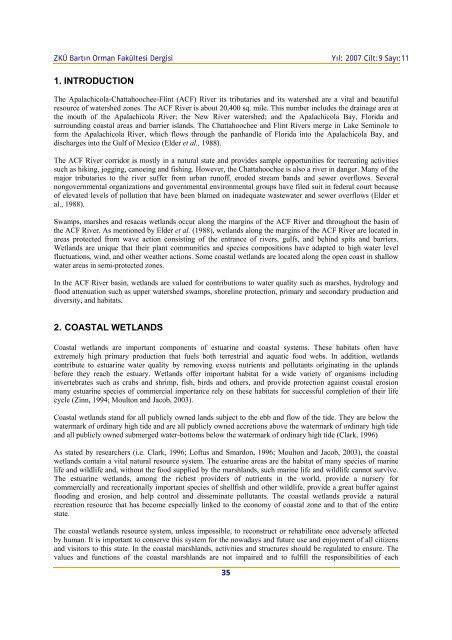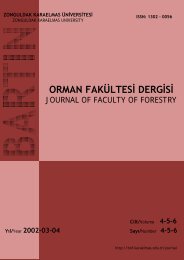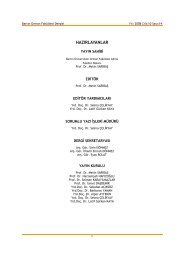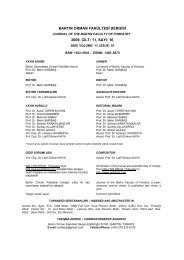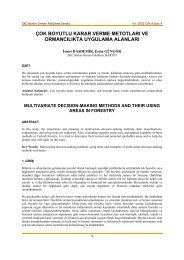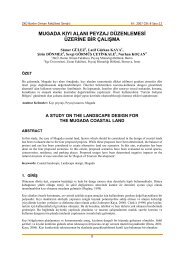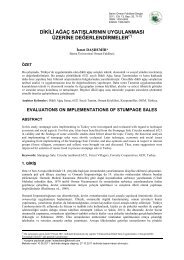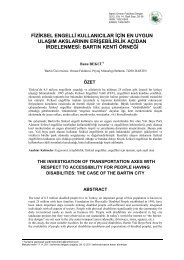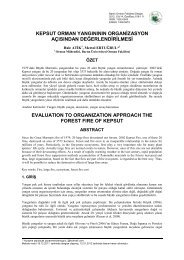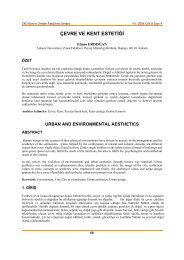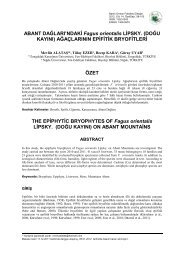ORMAN FAKÜLTESİ DERGİSİ
Tamamını İndir - Orman Fakültesi
Tamamını İndir - Orman Fakültesi
- No tags were found...
You also want an ePaper? Increase the reach of your titles
YUMPU automatically turns print PDFs into web optimized ePapers that Google loves.
ZKÜ Bartın Orman Fakültesi Dergisi<br />
Yıl: 2007 Cilt:9 Sayı:11<br />
1. INTRODUCTION<br />
The Apalachicola-Chattahoochee-Flint (ACF) River its tributaries and its watershed are a vital and beautiful<br />
resource of watershed zones. The ACF River is about 20,400 sq. mile. This number includes the drainage area at<br />
the mouth of the Apalachicola River; the New River watershed; and the Apalachicola Bay, Florida and<br />
surrounding coastal areas and barrier islands. The Chattahoochee and Flint Rivers merge in Lake Seminole to<br />
form the Apalachicola River, which flows through the panhandle of Florida into the Apalachicola Bay, and<br />
discharges into the Gulf of Mexico (Elder et al., 1988).<br />
The ACF River corridor is mostly in a natural state and provides sample opportunities for recreating activities<br />
such as hiking, jogging, canoeing and fishing. However, the Chattahoochee is also a river in danger. Many of the<br />
major tributaries to the river suffer from urban runoff, eroded stream bands and sewer overflows. Several<br />
nongovernmental organizations and governmental environmental groups have filed suit in federal court because<br />
of elevated levels of pollution that have been blamed on inadequate wastewater and sewer overflows (Elder et<br />
al., 1988).<br />
Swamps, marshes and resacas wetlands occur along the margins of the ACF River and throughout the basin of<br />
the ACF River. As mentioned by Elder et al. (1988), wetlands along the margins of the ACF River are located in<br />
areas protected from wave action consisting of the entrance of rivers, gulfs, and behind spits and barriers.<br />
Wetlands are unique that their plant communities and species compositions have adapted to high water level<br />
fluctuations, wind, and other weather actions. Some coastal wetlands are located along the open coast in shallow<br />
water areas in semi-protected zones.<br />
In the ACF River basin, wetlands are valued for contributions to water quality such as marshes, hydrology and<br />
flood attenuation such as upper watershed swamps, shoreline protection, primary and secondary production and<br />
diversity, and habitats.<br />
2. COASTAL WETLANDS<br />
Coastal wetlands are important components of estuarine and coastal systems. These habitats often have<br />
extremely high primary production that fuels both terrestrial and aquatic food webs. In addition, wetlands<br />
contribute to estuarine water quality by removing excess nutrients and pollutants originating in the uplands<br />
before they reach the estuary. Wetlands offer important habitat for a wide variety of organisms including<br />
invertebrates such as crabs and shrimp, fish, birds and others, and provide protection against coastal erosion<br />
many estuarine species of commercial importance rely on these habitats for successful completion of their life<br />
cycle (Zinn, 1994; Moulton and Jacob, 2003).<br />
Coastal wetlands stand for all publicly owned lands subject to the ebb and flow of the tide. They are below the<br />
watermark of ordinary high tide and are all publicly owned accretions above the watermark of ordinary high tide<br />
and all publicly owned submerged water-bottoms below the watermark of ordinary high tide (Clark, 1996)<br />
As stated by researchers (i.e. Clark, 1996; Loftus and Smardon, 1996; Moulton and Jacob, 2003), the coastal<br />
wetlands contain a vital natural resource system. The estuarine areas are the habitat of many species of marine<br />
life and wildlife and, without the food supplied by the marshlands, such marine life and wildlife cannot survive.<br />
The estuarine wetlands, among the richest providers of nutrients in the world, provide a nursery for<br />
commercially and recreationally important species of shellfish and other wildlife, provide a great buffer against<br />
flooding and erosion, and help control and disseminate pollutants. The coastal wetlands provide a natural<br />
recreation resource that has become especially linked to the economy of coastal zone and to that of the entire<br />
state.<br />
The coastal wetlands resource system, unless impossible, to reconstruct or rehabilitate once adversely affected<br />
by human. It is important to conserve this system for the nowadays and future use and enjoyment of all citizens<br />
and visitors to this state. In the coastal marshlands, activities and structures should be regulated to ensure. The<br />
values and functions of the coastal marshlands are not impaired and to fulfill the responsibilities of each<br />
35


